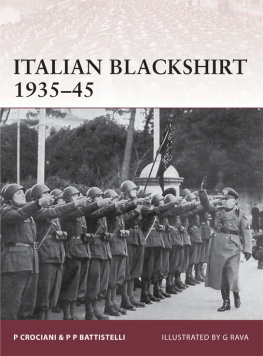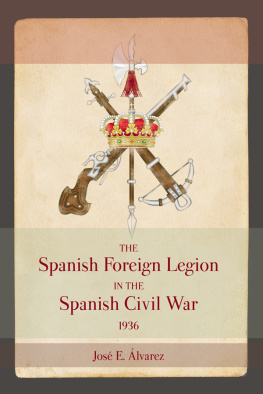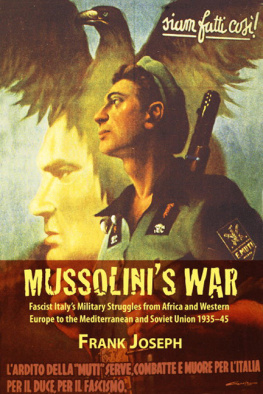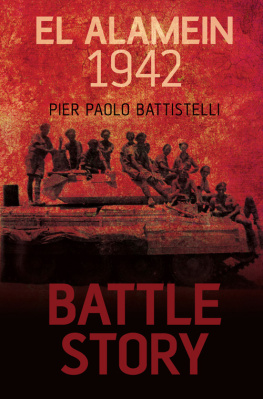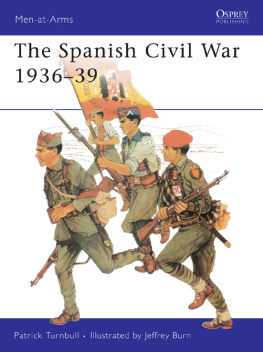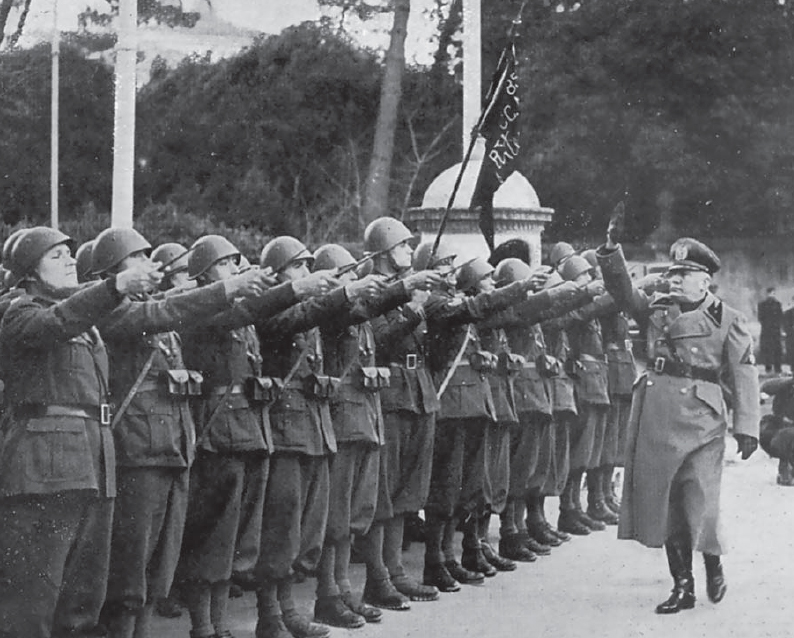ITALIAN BLACKSHIRT 193545
| P CROCIANI & P P BATTISTELLI | ILLUSTRATED BY G RAVA |
CONTENTS
ITALIAN BLACKSHIRT 193545
INTRODUCTION
The origins of the Camicie Nere (Blackshirts) date back to the months after the end of World War I, when Italy was riven by social and political struggle. The Squadre dAzione (action squads, their members being called Squadristi) came into being in reaction both to the mutilated victory which deprived Italy of what she considered her rightful gains, and to the rise of the socialist-communist party. Controlled by Benito Mussolini, the Squadre were made up of war veterans and young people led by charismatic local fascist leaders known as ras (ringleaders), after the Ethiopian term for chief; violence was the main instrument used to intimidate their adversaries, which led to frequent bouts of street-fighting. Their paramilitary organization had its roots both in the Arditi, the Italian assault units of World War I (see Warrior 87: Italian Arditi, Angelo L. Pirocchi, Osprey Publishing: Oxford, 2004), and in the legions of ancient Rome. The creation on 23 March 1919 of the Fasci di Combattimento (Fighting Fascists) gave a political basis to the movement, which was later transformed into the Partito Nazionale Fascista (National Fascist Party). The latter played a vital role in Mussolinis rise to power on 28 October 1922, when four columns of Blackshirts marched unopposed on Rome.
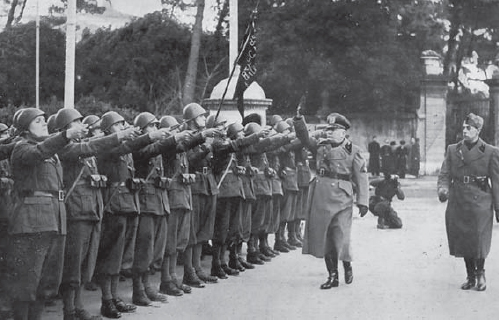
Mussolini, dressed in the uniform of Primo Caporale donore della Milizia, reviews a Blackshirt battalion, who are saluting with raised daggers in front of the MVSNs headquarters. To the right is Luogotenente Generale Enzo Galbiati, chief of staff of the MVSN from May 1941 to July 1943. (Archivio Centrale dello Stato, Rome)
Soon after this event, the Blackshirts somewhat haphazard organization was incorporated within the framework of the nascent Fascist state. On 1 February 1923 the Milizia Volontaria Sicurezza Nazionale (MVSN, National Security Volunteer Militia) was officially created out of the Blackshirt cadre, both the rank and file and its leadership. This provided a twofold solution to a particular problem: firstly it brought an otherwise wildly irregular force that was often exclusively in the hands of the ras under control, and secondly it turned the Fascist Partys militia into a national institution. The MVSN was a nationwide organization with a territorial basis, like a territorial army, with almost every Italian province (equivalent to a county) or large city having its own legione (legion) that was itself subdivided into coorti (cohorts) and centurie (centuries), adopting the nomenclature of the ancient Roman army. The actual organization only provided a framework of service, as the Blackshirts were only called to duty when circumstances demanded.
The first duty of the MVSN was to maintain law and order. This also included conflict with any form of opposition to Mussolini and the Fascist regime, though this was now done via cooperating with the local state authorities and the police forces, rather than directly fighting them, as had been the case before Mussolinis rise to power. By the late 1920s the MVSN had changed from being a party militia into a state organization, and despite it growing ever larger in size it had by then lost most of its original ideological coherence. Policing duties were mainly taken back by the state police forces, which were now fully controlled by the Fascist authorities; only limited and highly specialized police tasks were retained by the special branches of the MVSN. Deprived of a great deal of their original political ethos, which survived mainly in their external appearance, the Blackshirts seemed destined merely to provide a decorative element to Fascist mass meetings and celebrations. However, it was precisely at this point that Mussolini created a new role for the Blackshirts, and they began to develop as a combat force.
CHRONOLOGY
| 1919 | Mussolini organizes the Squadre dAzione (Action Squads) to combat his political adversaries. |
| 23 March 1919 | Mussolini founds the Fasci di combattimento (Fighting Fascists) in Milan. |
| 7 November 1921 | The Fasci di combattimento are transformed into the Partito Nazionale Fascista (Fascist National Party). The Squadre dAzione are brought under central control and reorganized; their members become known as Camicie Nere after their black shirts. |
| 28 October 1922 | Fascist march on Rome takes place, leading to Mussolinis rise to power. |
| 15 December 1922 | The Fascist Grand Council creates the Milizia Volontaria Sicurezza Nazionale (MVSN). |
| 1 February 1923 | The Squadre dAzione are disbanded and the Blackshirts are absorbed into it. Blackshirts legions are created throughout Italy. |
| 1 September 1923 | The first three combat legions are mobilized and sent to Libya. |
| 1317 June 1924 | Following the murder of the Socialist member of parliament Giacomo Matteotti, Mussolini uses four combat legions to restore public order the last time the Blackshirts will be used for civil-order duties. |
| 1 August 1924 | The MVSN is reorganized as part of the Italian armed forces, and swear loyalty to the king. |
| 3 January 1925 | Mussolini claims political responsibility for the killing of Matteotti, marking the beginning of his dictatorship. |
| 9 October 1926 | Mussolini becomes Comandante Generale (commander in chief) of the MVSN |
| November 1927 | The Milizia per la difesa antiaerea del territorio (MDAT, anti-aircraft home defence) is created. |
| 10 July 1928 | The army frees up any Blackshirts aged between 26 and 36 to join the Blackshirt combat battalions; two battalions take part in army manoeuvres and later form Blackshirt legions. |
| 29 March 1930 | The legions are attached to Italian army divisions. |
| 1934 | The Milizia artiglieria da costa (DACOS, coastal artillery militia) is created. |
| 5 December 1934 | Border incidents occur between Italy and Ethiopia in Italian Somaliland. |
| Summer 1935 | 29 Blackshirt legioni or battalion groups are mobilized; these f orm seven divisions, five of which are deployed in Eritrea (plus one in Italian Somaliland). By October, there are 132 Blackshirt legions, each having one operational and one territorial battalion. |
| 3 October 1935 | Italy invades Ethiopia. After an early advance, operations stall, and in December General Badoglio takes over command. |
| January 1936 | Italian forces resume the offensive, leading to the seizure of Addis Ababa in May 1936. |
| 9 May 1936 | Mussolini declares the birth of the new Roman empire; shortly after the end of the Italo-Ethiopian War, the Blackshirt divisions are disbanded and the legions demobilized. |
| 19 July 1936 | The day after the outbreak of the Spanish Civil War, Francisco Franco asks for German and Italian support for the Nationalist cause; volunteer recruitment begins in Italy. |
| 24 October 1936 | The RomeBerlin Axis, a GermanItalian agreement, is founded. |

